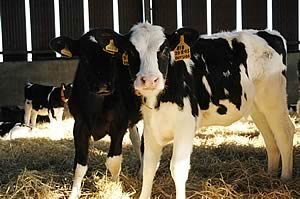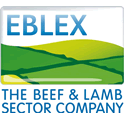24/11/08
Dairy farmers keen to make the most of their surplus calves this winter need to pay particular attention to ensuring they all receive sufficient good quality colostrum in the first 24 hours of life, warns EBLEX Ltd, the industry body for beef and lamb levy-payers in England, following worrying indications from recent random blood testing.
The latest blood testing, carried out on batches of calves from a number of dairy farms sold for rearing at approximately two weeks of age, revealed over half of calves with immunoglobulin levels below the 20 ZST units considered adequate to provide sufficient passive immunity to early disease infections.
While some calves showed reasonable levels of immunoglobulins, the testing clearly suggests many are failing to receive sufficient antibody protection from their dams, making them particularly susceptible to digestive and respiratory tract infections. What is more, colostrum also contains key nutrients, vitamins and minerals which are essential to achieve the best start in life.
Although failing to do so is understandable given the management pressures most modern dairy herds are under, EBLEX stresses that putting sufficient time and attention into ensuring all calves get the colostrum they need can do much to maximise returns from calf buyers at little or no extra cost.
Pointing out that quality, quantity, time of feeding and cleanliness of colostrum are all important factors governing its effectiveness in improving calf health, performance and welfare, EBLEX urges dairy herd managers to appreciate that:
Calves should receive six pints of colostrum in the first six hours of life (2-3 litres, ideally as two feeds);
- Just leaving calves to suckle for themselves may not be sufficient to ensure this, especially with weak individuals or those that have had assisted births;
- Colostrum absorption is best when calves are fed from a cow or bottle and teat, but a stomach tube should be used wherever there is any doubt over consumption;
- Colostrum quality can vary due to many factors and only feeding high quality colostrum which feels thick between the fingers (or as measured on a colostrometer) is vital;
- If colostrum quality is poor, reserves previously stored from another cow with plentiful, good quality colostrum should be used, having assessed her Johne’s disease status, of course;
- Heifers tend to produce less colostrum of lower quality than mature cows and may need assistance to ensure good early mothering; and,
- Vaccination of cows against rotavirus, coronavirus, and other diseases before calving is a good way of ensuring sufficient antibodies against these problems in their colostrum;
Further, practical advice on management to improve young calf survival, performance and welfare is available free of charge to levy payers through the interactive Beef Action for Profit resource on the beef section of www.eblex.org.uk.
 Cattle Industry Commitment to Ear Tags Not in Doubt Cattle Industry Commitment to Ear Tags Not in Doubt
 Dungannon Charolais Cattle Peak at 4,800gns Dungannon Charolais Cattle Peak at 4,800gns
 Commercial Demand Drives Welshpool Charolais to 5,400gns Commercial Demand Drives Welshpool Charolais to 5,400gns
|



